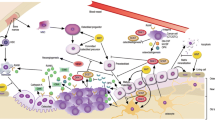Abstract
In the present study, we examined the effects of a newly developed bisphosphonate, minodronate (YM529), on osteolytic bone metastasis caused by lung cancer. Human small-cell lung cancer (SBC-5) cells, injected intravenously into natural killer cell-depleted SCID mice, produced radiologically detectable bone metastasis by day 18 and macroscopically visible visceral metastases (lung, liver, kidney, systemic lymph node) by day 35. Prophylactic treatment with YM529 on day 1 significantly inhibited the formation of osteolytic bone metastasis evaluated on X-ray photographs in a dose-dependent manner. In addition, treatment with YM529 after establishment of bone metastasis (on day 21) also inhibited bone metastasis, although the treatment was more effective when started earlier. Single administration was as effective as repeated treatment, suggesting a sustained inhibitory effect of YM529 on bone metastasis. YM529 reduced the number of osteoclasts in the bone metastatic lesions in vivo, but had no effect on the proliferation or cytokine production of SBC-5 cells in vitro. These results suggest that YM529 is a potent inhibitor of bone metastasis of human lung cancer, probably by suppressing osteoclastic bone resorption. In contrast, treatment with YM529 had no effect on visceral metastasis, even if started on day 1, and did not prolong the survival of the mice. Therefore, development of a combined modality is necessary for prolonging the survival of small-cell lung cancer patients with multiple-organ metastasis.
Similar content being viewed by others
References
Ishikawa H, Satoh H, Kurishima K et al. Lung cancer with synchronous brain and bone metastasis. Clin Oncol (R Coll Radiol) 2000; 12: 136–7.
Quint LE, Francis IR, Wahl RL et al. Imaging of lung cancer. In Pas HI, Mitchells JB, Johnson DH, Turrisi AT (eds): Lung Cancer: Principles and Practice. Philadelphia: Lippincott-Raven 1996; 437–70.
Yano S, Nishioka Y, Izumi K et al. Novel metastasis model of human lung cancer in SCID mice depleted of NK cells. Int J Cancer 1996; 67: 211–7.
Sullivan FJ.Palliative radiotherapy for lung cancer. In Pass HI, Mitchell JB, Johnson DH, Turrisi AT (eds): Lung Cancer: Principles and Practice. Philadelphia: Lippincott-Raven 1996; 775–89.
Theriault RL, Hortobagyi GN. The evolving role of bisphosphonates. Semin Oncol 2001; 28: 284–90.
Body JJ, Barttl R, Burckhardt P et al. Current use of bisphosphonates in oncology. J Clin Oncol 1998; 16: 3890–9.
Rizzoli R, Forni M, Schaad MA et al. Effects of oral clodronate on bone mineral density in patients with relapsing breast cancer. Bone 1996; 18: 531–7.
Smith JA Jr. Palliation of painful bone metastases from prostate cancer using sodium etidronate: Results of a randomized, prospective, double-blind, placebo-controlled study. J Urol 1989; 141: 85–7.
Stearns ME, Wang M. Effects of alendronate and taxol on PC-3 ML cell bone metastases in SCID mice. Invasion Metastasis 1996; 16: 116–31.
Yoneda T, Sasaki A, Dunstan C et al. Inhibition of osteolytic bone metastasis of breast cancer by combined treatment with YM529 inhibits osteolytic bone metastasis caused by lung cancer 159 the bisphosphonate ibandronate and tissue inhibitor of the matrix metalloproteinase-2. J Clin Invest 1997; 99: 2509–17.
Theriault RL, Lipton A, Hortobagyi GN et al. Pamidronate reduces skeletal morbidity in women with advanced breast cancer and lytic bone lesions: A randomized, placebo-controlled trial. Protocol 18 Aredia Breast Cancer Study Group. J Clin Oncol 1999; 17: 846–54.
Berenson JR, Vescio RA, Rosen LS et al. A phase I dose-ranging trial of monthly infusions of zoledronic acid for the treatment of osteolytic bone metastases. Clin Cancer Res 2001; 7: 478–85.
Benford HL, Frith JC, Auriola S et al. Farnesol and geranylgeraniol prevent activation of caspases by aminobisphosphonates: Biochemical evidence for two distinct pharmacological classes of bisphosphonate drugs. Mol Pharmacol 1999; 56: 131–40.
Rogers MJ, Watts DJ, Russell RG. Overview of bisphosphonates. Cancer 1997; 80 (Suppl): 1652–60.
Hillner BE, Ingle JN, Berenson JR et al. American Society of Clinical Oncology guideline on the role of bisphosphonates in breast cancer. American Society of Clinical Oncology Bisphosphonates Expert Panel. J Clin Oncol 2000; 18: 1378–91.
Sasaki A, Kitamura K, Alcalde RE et al. Effect of a newly developed bisphosphonate, YH529, on osteolytic bone metastases in nude mice. Int J Cancer 1998; 77: 279–85.
Miki T, Yano S, Hanibuchi Met al. Bone metastasis model with multiorgan dissemination of human small-cell lung cancer (SBC-5) cells in natural killer cell-depleted SCID mice. Oncol Res 2000; 12: 209–17.
Hauschka PV, Manrakos AE, Iafrati MD et al. Growth factors in bone matrix. Isolation of multiple types by affinity chromatography on heparin-sepharose. J Biol Chem 1986; 261: 12665–74.
Pfeilschifter J, Mundy GR. Modulation of transforming growth factor beta activity in bone cultures by osteotropic hormones. Proc Natl Acad Sci USA 1987; 84: 2024–8.
Lee MV, Fong EM, Singer FR et al. Bisphosphonate treatment inhibit the growth of prostate cancer cells. Cancer Res 2001; 61: 2602–8.
Senaratne SG, Pirianov G, Mansi JL et al. Bisphosphonates induce apoptosis in human breast cancer cell lines. Br J Cancer 2000; 82: 1459–68.
Takahashi R, Shimazaki C, Inaba T et al. A newly developed bisphosphonate, YM529, is a potent apoptosis inducer of human myeloma cells. Leuk Res 2001; 25: 77–83.
Sasaki A, Boyce BF, Story B et al. Bisphosphonate risedronate reduces metastatic human breast cancer burden in bone in nude mice. Cancer Res 1995; 55: 3551–7.
Author information
Authors and Affiliations
Corresponding author
Rights and permissions
About this article
Cite this article
Zhang, H., Yano, S., Miki, T. et al. A novel bisphosphonate minodronate (YM529) specifically inhibits osteolytic bone metastasis produced by human small-cell lung cancer cells in NK-cell depleted SCID mice. Clin Exp Metastasis 20, 153–159 (2003). https://doi.org/10.1023/A:1022621622063
Issue Date:
DOI: https://doi.org/10.1023/A:1022621622063




